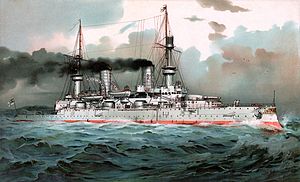Kaiser Friedrich III-class battleship

SMS Kaiser Wilhelm II
|
|
| Class overview | |
|---|---|
| Builders: |
|
| Operators: |
|
| Preceded by: | Brandenburg class |
| Succeeded by: | Wittelsbach class |
| Built: | 1895–1901 |
| Completed: | 5 |
| Scrapped: | 5 |
| General characteristics | |
| Class and type: | Pre-dreadnought battleship |
| Displacement: |
|
| Length: | 125.3 m (411 ft 1 in) |
| Beam: | 20.4 m (66 ft 11 in) |
| Draft: | 7.89 m (25 ft 11 in) |
| Propulsion: | |
| Speed: | 17.5 knots (32.4 km/h; 20.1 mph) |
| Range: | 3,420 nmi (6,330 km; 3,940 mi) at 10 knots (19 km/h; 12 mph) |
| Complement: | 658–687 |
| Armament: |
|
| Armor: |
|
Kaiser Friedrich III-class battleships were a class of pre–World War I, pre-dreadnought battleships of the German Kaiserliche Marine. The class was made up of five ships, all of which were named for German emperors. The Kaiser Friedrich III class saw the introduction of the traditional armament layout for German battleships—four large-caliber guns, but of comparatively smaller caliber compared to contemporary battleships, in two gun turrets—prior to the advent of the dreadnought type of battleship in the early 1900s. They also standardized the use of three screws for battleships.
Kaiser Friedrich III was laid down at Wilhelmshaven Navy Dockyard in March, 1895, followed by Kaiser Wilhelm II in October, 1896, also in Wilhelmshaven. Kaiser Wilhelm der Grosse was laid down at Germania, Kiel in January, 1898, followed by Kaiser Barbarossa at Schichau, Danzig in August of that year, and Kaiser Karl der Grosse, a month later in September, at Blohm & Voss, Hamburg. Work on all five vessels was completed by 1901.
The five Kaiser Friedrich III-class battleships were assigned to the I Squadron of the Home Fleet (Heimatflotte) after commissioning. Here they conducted extensive annual training maneuvers with the rest of the fleet. After ten years of fleet service, they were replaced with newer ships. They were transferred to the III Squadron of the fleet, which had by then been reorganized as the High Seas Fleet, and placed in reserve. The ships were recalled to active service at the outbreak of World War I, but saw limited duty during the war. They initially served in V Squadron, until 1915, when the ships were relegated to auxiliary roles, primarily as prison ships. After the war, all five of the ships were sold and scrapped by 1922.
...
Wikipedia
